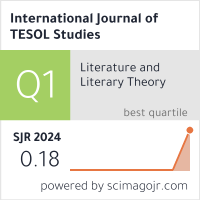2632-6779 (Print)
2633-6898 (Online)


Scopus
Ulrich’s Periodicals Directory (ProQuest)
MLA International Bibliography
MLA Directory of Periodicals
Directory of Open Access Journals (DOAJ)
QOAM (Quality Open Access Market)
British National Bibliography
WAC Clearinghouse Journal Listings
EBSCO Education
ICI Journals Master List
ERIH PLUS
CNKI Scholar
Gale-Cengage
WorldCat
Crossref
Baidu Scholar
British Library
J-Gate
ROAD
BASE
Publons
Google Scholar
Semantic Scholar
ORE Directory
TIRF
China National Center for Philosophy and Social Sciences Documentation
Shizhou Yang
Payap University, Thailand
Barry Lee Reynolds
University of Macau, China
Ever since Kachru’s (1970) landmark studies on Indian English, and with it, his three concentric-circle model of the global spread of English (Kachru, 1986), L2 creative writing has emerged as a unique line of intellectual inquiry. Instead of viewing English learners as negatively influenced by their cultural and linguistic backgrounds, L2 creative writing emphasizes such backgrounds as resources to draw upon to create new literature, or what Kachru termed as “contact literature” (Kachru, 1985). Although much literature and related studies by the end of the 20th century tended to focus on published L2 writers—Conrad, Raja Rao, Amy Tan, Ha Jin, to name just a few—increasingly, L2 creative writing is studied in diverse pedagogical contexts as well.
In the ESL context, a number of case studies in the past three decades have explored multilingual learners’ engagement with creative writing tasks such as memoire and literacy autobiographical writing (Canagarajah, 2015, 2020; Cummins et al., 2015). Other frequently used genres were poetry and fiction writing (Hanauer, 2010). All these studies point to the unique educational value of L2 creative writing, in particular, its capacity to engage in the learners’ experiences and subjectivities, and by so doing, adding to their identity options an experience-based sense of self as a creative writer. Zhao’s (2015) study is representative of this scholarship. Through her detailed description and careful analysis of ESL students’ creative writing and think-aloud transcriptions in English, Zhao argued that L2 creative writing identity was shaped by the writers’ past experiences and functioned as a symbolic capital to mediate their relationships with the world. Similarly, scholars embracing L2 creative writing in the form of poetry have demonstrated that literacy learning can be humanized. That is, it should not only engage the learners at the cognitive level, but also at the emotional, experiential, and imaginative levels.
The provision of L2 creative writing as a university course in the EFL context is a recent phenomenon. Its inclusion in the tertiary curriculum in Asian countries, whether as a required or elective course, seems to indicate a growing awareness that L2 creative writing can be taught, or at least, nurtured and that the emergent contact literature produced by these courses is important. The world today, so entangled with the English language and so entrenched in the classics, needs a different voice. The English education worldwide, so confined by native-speakerism, monolingualism, and standard-English only dictum, needs a creative deviation. Classroom-based L2 creative writing studies in the EFL context have identified a wide range of benefits such as increasing the learners’ engagement, boosting their confidence, and contributing to their language development (Yang, 2020; Yang & Nong, 2019; Yang & Reynolds, 2022).